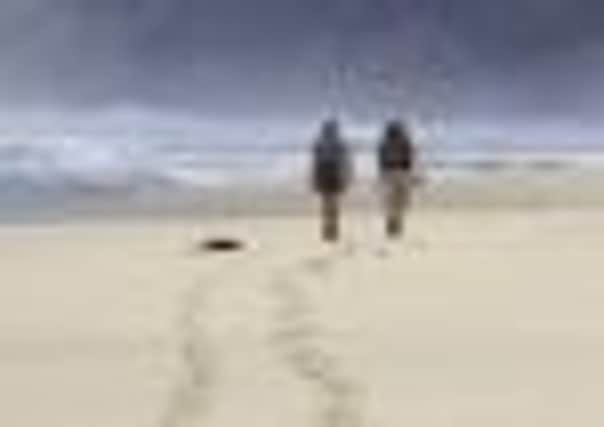One step at a time


THE journey spanned more than 10,000 miles, involved three flights totalling more than 22 hours, a three-and-a-half hour car drive which sandwiched a 20-minute ferry ride – and a walk from the car park of no more than a couple of hundred yards. That’s how I came to be standing on Johanna Beach in the state of Victoria on the south-east coast of Australia.
Now the hard part. How to convey my overwhelmed and almost bewildered state as I stood gazing at the relentless waves surging in off the Southern Ocean. It might have been a moment to take my breath away had Gavin Ronan, the man who had guided our party on the final mile of our journey, not encouraged us to suck in the air. “Head straight out to sea, and the first land mass you would hit is Antarctica, 5,000km away,” said Gavin. “That’s why the air coming off the ocean is as pure as you’ll find anywhere in the world.”
Advertisement
Hide AdAdvertisement
Hide AdGavin and his wife are co-creators of bothfeet walking lodge, an eco-friendly base of five family rooms built at the centre of the Great Ocean Walk, a 65-mile hiking trail which attracts visitors from around the world. Six-day organised treks on the six-section trail are available or guests can explore the area and coastline at their own pace. Bothfeet offer prepared itineraries for guests’ use and, on request, will also create them tailored to suit clients’ ages, fitness and personal interests.


Unfortunately, this was a flying visit to Australia. With less than four days on Australian soil, our party was denied the chance to experience the Great Ocean Walk but it did afford us the time to take to the air on a brief helicopter ride just along the coast from Johanna Beach to get an aerial view of the Twelve Apostles.
These limestone rock stacks are the product of millions of years of tidal erosion and keep guard along the Southern Ocean coastline. Standing up to 45 metres high, they are the main feature of Port Campbell National Park, where a series of boardwalks, tracks and viewing areas enables visitors to survey their majesty.
Alternatively, many opt to view them from the air and our five-minute flight over the Apostles, although the highlight of the whirlwind stay, was so brief as to deny me the chance to count them and opinion seems divided as to how many have surrendered to the continuing process of erosion. Nine remain, we were told, then eight and someone even suggested their number had been halved.
Advertisement
Hide AdAdvertisement
Hide AdSuffice it to say the remaining sentinels are likely to be with us for some years to come so do not be panicked into believing their numbers will dwindle completely before you get the chance to see them. Besides, the accountancy skills of those hinting at their demise, fellow diners at the Montalto Vineyard and Olive Grove, may have been rendered less than reliable by the superb wines which had been imbibed.


The Mornington Peninsula, which stretches southwards from Melbourne down to Port Philip Bay, is a scenic region renowned for its vineyards and national parks. Montalto is a family-run business where diners can eat a la carte in the restaurant, al fresco in the Piazza and Garden Cafe, or at privately catered picnics at selected locations on the 50-acre estate. Although the cuisine takes its inspiration from France, ingredients are sourced from the estate, including its herb and vegetable garden, and the surrounding Mornington Peninsula. The fare is sumptuous and the location breathtaking.
Not to have sampled the area’s wines might have been considered a sin by some; similarly, to go to Australia and neither throw a boomerang nor espy a kangaroo also seems anathema, and so it was that our group was taken to the The Tower Hill State Game Reserve, in Warrnambool, to kill two birds with one stone, as it were.
None of us would have killed a bird with a boomerang despite our guide’s best attempts to school us in the art of throwing this implement and the koala clinging soporifically to a tree close to the arena appeared suitably unimpressed with our efforts. A group of kangaroos meandered close by, similarly disinterested, and nowhere near as excited to see us as we were them. Tower Hill, a national park nestling inside an extinct volcano, is home to many other indigenous creatures and appeared worthy of further exploration but our return home was looming and we headed back for a final look at Melbourne.
Advertisement
Hide AdAdvertisement
Hide AdSports enthusiasts from around the world know its name because of the Melbourne Cricket Ground, the race track which stages the Melbourne Cup and the Rod Laver Stadium, home to one of tennis’s four grand slam events every January. Should you wish to follow a less well-trodden path than to these sporting meccas then spend time in the hands of Hidden Secrets Walking Tours who will steer you away from the main arteries of Melbourne’s centre through a maze of speciality designers, retailers, cafe culture and historical lanes.


Victoria’s capital has its share of familiar high street stores but this tour pulled back the curtain on a vibrant inner core of shops, architecture and sculptural installations that would be missed by those sticking steadfastly to the beaten track. The MGC, I decided, can wait for another, at least five-day trip to Melbourne to take in an Ashes Test...
GETTING THERE
Emirates operates 105 flights per day from the UK (including three daily from Manchester) to Dubai where passengers can take an onward connection to Melbourne. Economy Class fares start from £970 per person. For more information or to make a reservation visit http://www.emirates.com/uk or call 0844 800 2777.